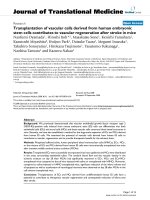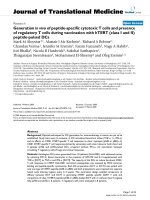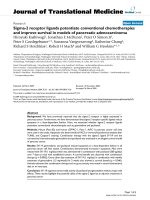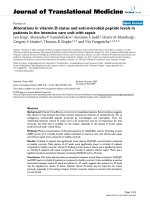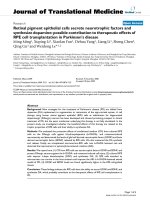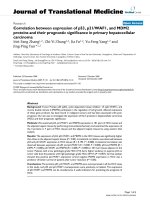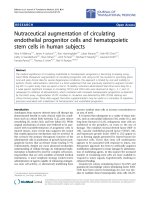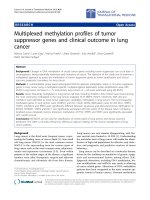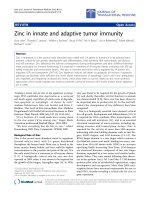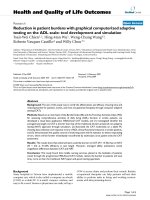Báo cáo hóa học: " Recombination in feline immunodeficiency virus from feral and companion domestic cats" docx
Bạn đang xem bản rút gọn của tài liệu. Xem và tải ngay bản đầy đủ của tài liệu tại đây (699.96 KB, 17 trang )
BioMed Central
Page 1 of 17
(page number not for citation purposes)
Virology Journal
Open Access
Research
Recombination in feline immunodeficiency virus from feral and
companion domestic cats
Jessica J Hayward* and Allen G Rodrigo
Address: Bioinformatics Institute, Allan Wilson Centre for Molecular Ecology and Evolution, School of Biological Sciences, The University of
Auckland, Auckland, New Zealand
Email: Jessica J Hayward* - ; Allen G Rodrigo -
* Corresponding author
Abstract
Background: Recombination is a relatively common phenomenon in retroviruses. We
investigated recombination in Feline Immunodeficiency Virus from naturally-infected New Zealand
domestic cats (Felis catus) by sequencing regions of the gag, pol and env genes.
Results: The occurrence of intragenic recombination was highest in env, with evidence of
recombination in 6.4% (n = 156) of all cats. A further recombinant was identified in each of the gag
(n = 48) and pol (n = 91) genes. Comparisons of phylogenetic trees across genes identified cases of
incongruence, indicating intergenic recombination. Three (7.7%, n = 39) of these incongruencies
were found to be significantly different using the Shimodaira-Hasegawa test.
Surprisingly, our phylogenies from the gag and pol genes showed that no New Zealand sequences
group with reference subtype C sequences within intrasubtype pairwise distances. Indeed, we find
one and two distinct unknown subtype groups in gag and pol, respectively. These observations
cause us to speculate that these New Zealand FIV strains have undergone several recombination
events between subtype A parent strains and undefined unknown subtype strains, similar to the
evolutionary history hypothesised for HIV-1 "subtype E".
Endpoint dilution sequencing was used to confirm the consensus sequences of the putative
recombinants and unknown subtype groups, providing evidence for the authenticity of these
sequences. Endpoint dilution sequencing also resulted in the identification of a dual infection event
in the env gene. In addition, an intrahost recombination event between variants of the same subtype
in the pol gene was established. This is the first known example of naturally-occurring
recombination in a cat with infection of the parent strains.
Conclusion: Evidence of intragenic recombination in the gag, pol and env regions, and complex
intergenic recombination, of FIV from naturally-infected domestic cats in New Zealand was found.
Strains of unknown subtype were identified in all three gene regions. These results have
implications for the use of the current FIV vaccine in New Zealand.
Published: 17 June 2008
Virology Journal 2008, 5:76 doi:10.1186/1743-422X-5-76
Received: 25 April 2008
Accepted: 17 June 2008
This article is available from: />© 2008 Hayward and Rodrigo; licensee BioMed Central Ltd.
This is an Open Access article distributed under the terms of the Creative Commons Attribution License ( />),
which permits unrestricted use, distribution, and reproduction in any medium, provided the original work is properly cited.
Virology Journal 2008, 5:76 />Page 2 of 17
(page number not for citation purposes)
Background
Feline Immunodeficiency Virus (FIV) is a retrovirus that spe-
cifically infects felines and hyaenas [1]. In the strain that
infects the domestic cat, Felis catus (FIV-Fca), five phyloge-
netic subtypes have been described, labelled A to E [2-4].
These subtypes are based on the V3 to V5 region of the env
gene, with some recent studies confirming phylogenies
using the gag gene [2,5-8]. In the env gene, intrasubtype
pairwise distances of up to about 14% are observed, while
intersubtype distances of 15% to 38% are commonly
found [2,4,8]. Recently, we and others have proposed
potentially novel subtypes based on phylogenetically-dis-
tinct sequence groups that differ from known subtypes
[5,9,10].
The env gene encodes the viral surface and transmem-
brane glycoproteins, gp120 and gp41 respectively. These
glycoproteins are involved in host cell recognition and
have been shown to contain epitopes that elicit cell-medi-
ated and humoral immune responses in FIV-infected indi-
viduals [11,12]. As this region of the viral genome is likely
to be under strong selection, it is likely to change rapidly.
As a retrovirus, FIV has a relatively high evolutionary rate,
on the order of 1–3% per decade in the env and pol genes
of the cougar strain, FIV-Pco [13]. This high rate is largely
attributed to substitution errors made during reverse tran-
scription [14]. However, as a retrovirus with a diploid
genome, the phenomenon of recombination is also very
important in the evolution of FIV. Recombination occurs
as a result of template-switching by the enzyme reverse
transcriptase when the particular infecting virion has a het-
erozygous genome [15]. Hence, a prerequisite for recom-
bination is dual infection. Previously, three naturally-
infected cats have been identified with FIV intersubtype
dual infections: one with subtypes A and B from USA [16],
and two with subtypes A and C from New Zealand (NZ)
[17]. In addition, a natural superinfection event has been
documented between two subtype A FIV-infected cats
housed together in Australia [18]. The superinfected cat
has its own unique FIV strains that had been isolated from
the cat previously and additional FIV strains that show
within 6.8% nucleotide similarity to the FIV strains iso-
lated from the cat inhabiting the same house [18]. Natu-
rally-occurring FIV-Fca intersubtype recombination has
been described in domestic cats from Canada, Hawaii,
USA and Japan [6,16,19].
In our previous study of FIV env gene sequences in NZ
domestic cats, we found subtypes A and C, nine putative
A/C recombinants and a group of sequences of an
unknown and phylogenetically-distinct subtype [10].
Here we further investigate the occurrence of recombinant
sequences in naturally-infected NZ domestic cats using
the gag and pol genes, in addition to env. We find an addi-
tional intragenic recombinant in the env gene, giving ten
recombinant sequences for this gene, or 6.4% (n = 156).
From each of the gag and pol gene regions we find only
one (2.1% and 1.1% respectively) intragenic recom-
binant. Our results also show that the previously-pro-
posed unknown subtype sequences from the env gene do
not show the same monophyletic grouping in the gag and
pol regions. In addition, we find inconsistencies in sub-
type C designation in the gag and pol genes. We suggest
that the patterns seen in these samples are the result of
multiple recombination events throughout the FIV
genome. The results illustrate the importance of sequenc-
ing and analysing multiple genes to gain a more complete
picture of recombination events.
Results
Phylogenetic trees
The env NJ phylogenetic tree (Fig. 1) shows three main
groups, which are subtypes A, C and an unknown (U-
NZenv), as previously shown [10]. One further sequence,
in addition to the 17 sequences from our earlier study,
now falls in the unknown group. Average K2P distances
suggest that the unknown group could be a new subtype,
with distances ranging from 20.6% to 22.7% between the
unknown and other subtypes (Table 1). Also seen in the
env NJ tree are 13 outliers, 11 of which were documented
in our previous study [10].
The gag NJ tree (Fig. 2) features two large groups of NZ
sequences, one of which is subtype A. The other group of
sequences (U-NZgag) is monophyletic with subtype C ref-
erence sequences (BM3070 and CaONC02 from Canada,
and FIV-C36 from USA). However, U-NZgag sequences
Table 1: Average percentage K2P nucleotide distances between and within all env sequences of different subtypes included in this
study, as shown in Fig. 1
Subtype A Subtype B Subtype C Subtype D Subtype E U-NZenv
Subtype A 8.07
Subtype B 23.04 9.82
Subtype C 23.54 21.36 7.38
Subtype D 23.03 17.94 22.08 8.91
Subtype E 23.31 15.84 23.22 19.03 5.03
U-NZenv 21.44 21.69 20.63 22.73 22.06 2.44
Virology Journal 2008, 5:76 />Page 3 of 17
(page number not for citation purposes)
NJ phylogenetic tree of env sequences from NZ domestic catsFigure 1
NJ phylogenetic tree of env sequences from NZ domestic cats. Tree is rooted by subtype B. Subtypes are shown along
the right side of the tree. Bootstrap values based on 1000 replicates are shown for the major groups. Sequences with ⇐ are
used as reference sequences in the RIP analyses. Outlier sequences are 258, PN22, 259, 168, PN17, PN23, PN27, PN21, PN18,
197, 260, MF14, 214. U-NZenv is a group of NZ sequences that does not group with a known subtype. Reference sequences
from GENBANK are; subtype A: Sendai1 (D37813
, Japan), Petaluma (M25381, USA), DEBAb91 (AF531043, Germany), UK2
(X69494
, UK), SwissZ2 (X57001, Switzerland), Wo (L06135, France) and Ca2 (DQ873714, South Africa); subtype B: TM2
(M59418
, Japan), ItalyM2 (X69501, Italy), ATVIa33 (AF531045, Austria), LP9 (D84497, Argentina) and 14-02PalP (DQ072558,
Portugal); subtype C: CABCpbar01C (U02393
, Canada), TI-2 (AB016026, Taiwan), DEBAfred (U57020, Germany), BM3070
(AF474246
, Canada), FIV-C36 (AY600517, USA) and VND-8 (AB083509, Vietnam); subtype D: MC8 (D67062, Japan), Shizuoka
(D37811
, Japan), Fukuoka (D37815, Japan) and VND-1 (AB083502, Vietnam); subtype E: LP3 (D84496, Argentina) and LP20
(D84498
, Argentina).
ItalyM2
TM2
LP9
ATVIa33
LP3
LP20
VND-1
MC8
Shizuoka
Fukuoka
CABCpbar01C
FIV-C36
BM307
VND-8
DEBAfred
TI-2
214
MF14
260
197
PN18
DEBAb91
Ca2
Petaluma
Sendai1
SwissZ2
UK2
Wo
PN21
PN27
PN23
PN17
168
259
PN22
258
0.05
93
100
79
92
U-NZenv
C
A
B
D
E
98
100
78
14-02PalP
⇐
⇐
Virology Journal 2008, 5:76 />Page 4 of 17
(page number not for citation purposes)
are quite distantly related to the subtype C sequences,
with an average K2P distance of 15.64%, a value greater
than intrasubtype gag distances and consistent with inter-
subtype gag distances (Table 2). This level of similarity
indicates that the U-NZgag and C groups may be distinct
but related subtypes.
Interestingly, when we include the four subtype C isolates
from Taiwan (TI-1 (AB027298
), TI-2 (AB027299), TI-3
(AB027300
), TI-4 (AB027301)) [20] by cropping about
550 bp from the start of our gag sequence alignment, we
find that the Taiwan isolates group with the U-NZgag
sequences (average K2P distance of 3.74%; tree not
shown). This finding adds weight to the validity of the U-
NZgag sequences and also suggests a common origin
between NZ and Taiwanese FIV.
The pol NJ tree (Fig. 3) shows NZ sequences split into three
groups. One of these is subtype A. The other two groups
of sequences (U-NZpol1 and U-NZpol2) do not belong to
a known subtype. Although U-NZpol2 forms a mono-
phyletic group with subtype C, the average K2P distance
of 8.88% (Table 3) is higher than all other pol intrasub-
type distances. RIP analyses also show that the nine
sequences belonging to U-NZpol2 are most similar to
subtype C, with strongest similarity in the second "half" of
the sequences (data not shown).
The largest group of NZ pol sequences, U-NZpol1, is most
closely related to subtype A (Table 3). This cluster of
sequences does not form a monophyletic group. How-
ever, when the recombinant sequence PN9 is removed
and a NJ tree reconstructed, U-NZpol1 does form a mono-
phyletic group (data not shown). RIP analysis shows that
this group of sequences look like recombinants of subtype
A and C. However, KH test results are not significant for
these sequences (data not shown).
Intragenic recombination
Env
RIP outputs show that the two new env outliers are poten-
tial recombinant sequences, with clear crossover patterns
(Fig. 4A). The Kishino-Hasegawa (KH) test shows signifi-
cant results for both halves of the query sequence for one
of these additional outliers (PN18; data not shown).
From the RIP alignments and visual inspection of the
sequences, the approximate locations of the putative
crossover points for each env putative recombinant
sequence were determined. Of the ten putative recom-
binant sequences (nine from our previous study and one
from the present study), there are only six unique recom-
binant patterns, all involving subtypes A and C (Table 4).
Four cats share one recombinant pattern with two crosso-
vers and two cats share another with only a single crosso-
ver. One particular crossover site (range of 7508–7522) is
featured in six NZ sequences.
From a total of 156 FIV-infected NZ cat env sequences sub-
jected to phylogenetic analysis, thirteen outliers were
identified. Ten of the thirteen outlier sequences had sig-
nificantly different topologies constructed from each side
of the crossover site as determined by the KH test. Thus,
ten (6.4%) putative recombinants were found.
Given the level of recombination that we have found in
env, we suspect that there are a significant number of
undetected putative recombinant sequences in public
databases, incorrectly identified as belonging to a particu-
lar subtype. For example, a recent study on FIV strains in
cats of Portugal found two outlying env sequences
(150_02LisP and 164_02UZP) that were initially assigned
into subtype A [9]. However, genetic divergence analysis
and an amino acid phylogenetic tree indicated that the
correct location was in a subcluster of subtype B [9]. We
analysed the two suspicious sequences using RIP and the
KH test, and found that they both show a statistically sig-
nificant intragenic B/A recombination event (Fig. 5; Table
5).
Gag
There is only a single outlier sequence in the gag NJ tree
(PN6; Fig. 2). This was tested for recombination using RIP
and shows a clear recombination pattern, with two cross-
over events (Fig. 4B). The KH test results confirm that this
sequence is a putative recombinant (Table 6). Ten end-
point dilution sequences were obtained for the gag region
of PN6, all of which group with the consensus sequence
on a NJ phylogenetic tree with a maximum pairwise dis-
tance of 1.42%. From a total of 48 FIV-infected NZ cat gag
sequences subjected to phylogenetic analysis, one (2.1%)
putative recombinant was found.
Pol
There are two outlier sequences on the pol NJ tree (Ni,
PN9; Fig. 3). The RIP output for Ni shows a recombina-
tion event between A/U-NZpol1 and U-NZpol2 (Fig.
4C(a)), although this is not statistically significant (Table
6). PN9, in contrast, suggests a recombination event
between subtype B and U-NZpol1 (Fig. 4C(b)), which is
statistically significant (Table 6). Note that although PN9
Table 2: Average percentage K2P nucleotide distances between
and within all gag sequences of different subtypes included in this
study, as shown in Fig. 2
Subtype A Subtype B Subtype C U-NZgag
Subtype A 3.58
Subtype B 15.03 6.32
Subtype C 13.38 16.95 2.49
U-NZgag 17.33 16.12 15.64 2.66
Virology Journal 2008, 5:76 />Page 5 of 17
(page number not for citation purposes)
NJ phylogenetic tree of gag sequences from NZ domestic catsFigure 2
NJ phylogenetic tree of gag sequences from NZ domestic cats. Tree is rooted by subtype B. Subtypes are shown along
the right side of the tree. Bootstrap values based on 1000 replicates are shown for the major groups. Sequences with ⇐ are
used as reference sequences in the RIP analyses. Outlier sequence is PN6. U-NZgag is a group of NZ sequences that does not
group with a known subtype. Reference sequences from GENBANK are; subtype A: CaONA22 (AY369383
, Canada), Peta-
luma (M25381
, USA); subtype B: CaONB06 (AY369381, Canada), TM2 (M59418, Japan), RP1 (AJ304962, Portugal); subtype C:
BM3070 (AF474246
, Canada), FIVC36 (AY600517, USA), CaONC02 (AY369384, Canada).
CaONB06
TM2
RP1
FIVC36
BM3070
CaONC02
Petalum
a
CaONA22
PN6
0.02
U-NZgag
A
B
C
100
99
100
100
100
99
⇐
⇐
Virology Journal 2008, 5:76 />Page 6 of 17
(page number not for citation purposes)
shows statistical significance between the two sides of the
putative crossover location, the similarity values to sub-
type B in the first part of the sequence are low. Only one
(1.1%) putative recombinant pol sequence is found from
analysing 91 samples in this region. This sequence is the
only recombinant involving subtype B found in a NZ cat.
Intergenic recombination
The incongruent subtype assignment seen in different
gene regions of nine NZ cat samples are shown in Fig. 6.
The ML tree that was determined to best describe the data
and thus used as the backbone constraint in further SH
tests, is the concatenated gene tree.
Significant results from the SH tests to determine differ-
ences in ML trees constructed with the inclusion of puta-
tive intergenic recombinant sequences are shown in Table
7. After the Bonferroni correction was applied, only five
pairs of ML trees returned statistically significant results
for the reciprocal SH tests. None of the significant results
involve the pol region.
Three of the five statistically significant SH test results
were between the gene trees for gag and env. Therefore, in
these three samples we have evidence of putative inter-
genic recombination.
Two of these samples (GBI84, WST05) also gave statisti-
cally significant results for incongruencies between the
concatenated tree and the gag gene tree. As a conservative
estimate, at least three of the 39 samples, or 7.7%, are
intergenic recombinants.
Unknown subtype
Representatives of the samples that make up the unknown
subtype of the env NJ tree were sequenced in the gag and
pol gene regions in order to confirm the existence of a
novel NZ-specific subtype. However, in the gag NJ tree, the
U-NZenv samples are found in subtype A and the U-
NZgag group. In the pol NJ tree, the U-NZenv sequences
are found in U-NZpol1 and U-NZpol2 groups. Thus, we
have no consistent evidence for a novel NZ-specific sub-
type across the three gene regions. Note that, due to low
viral load and sample quantity limitations, not all the
sequences of env unknown subtype have been amplified
in the gag and pol genes.
The discrepancies in the placement of the sequences of
unknown subtype seen between the phylogenetic trees
could be explained by multiple recombination events
between subtype A and undefined parent strains. This
possible explanation is similar to that suggested for HIV-1
subtype E (CRF_AE01), which is hypothesised to be a cir-
culating recombinant form of subtype A and an unknown
parent strain (subtype E) that has not been found [21].
Endpoint dilution sequencing
With the exception of two samples (see next section), all
endpoint dilution sequences and the respective consensus
sequence of the same sample are within 2.35% of each
other (Table 8). This shows that each consensus sequence
is a representative of a true proviral sequence and not an
example of PCR-mediated recombination as a result of
dual infection.
Intrahost recombination
One of the exceptions found from endpoint dilution
sequencing is the pol gene of sample TKP94. Eleven end-
point dilution sequences were obtained for this sample,
which fall into two main groups, comprising six and four
sequences (Fig. 7a). The eleventh sequence is an outlier
between these two groups and thus was submitted to RIP
as a check for recombination. The RIP output clearly
shows a crossover event between the two main groups
(Fig. 7b).
Given the pol evolutionary rate of 1–3% per decade, as
documented in FIV-Pco, [13], it would take between 17
and 52 years to generate diversity of 5.2% in an individual
as seen in the pol sequences from sample TKP94 (Table 8).
Since this particular individual is only a juvenile, we sug-
gest the explanation for the viral diversity found in this cat
is a result of same-subtype dual infection.
The second exception found from endpoint dilution
sequencing is seen in the env gene of TKP95. These four-
teen sequences have a maximum pairwise distance of
25.7%, a value resembling intersubtype distances. Indeed,
Table 3: Average percentage K2P nucleotide distances between and within all pol sequences of different subtypes included in this
study, as shown in Fig. 3
Subtype A Subtype B Subtype C U-NZpol1 U-NZpol2
Subtype A 3.69
Subtype B 14.57 2.99
Subtype C 12.82 15.63 0.23
U-NZpol1 8.33 14.04 13.32 2.66
U-NZpol2 13.41 17.43 8.88 14.20 2.37
Virology Journal 2008, 5:76 />Page 7 of 17
(page number not for citation purposes)
NJ phylogenetic tree of pol sequences from NZ domestic catsFigure 3
NJ phylogenetic tree of pol sequences from NZ domestic cats. Tree is rooted by subtype B. Subtypes are shown along
the right side of the tree. Bootstrap values based on 1000 replicates are shown for the major groups. Sequences with ⇐ are
used as reference sequences in the RIP analyses. Outlier sequences are Ni and PN9. U-NZpol1 and U-NZpol2 are groups of
NZ sequences that do not group with a known subtype. Reference sequences from GENBANK are; subtype A: T90 (S67753
,
Australia), Petaluma (M25381
, USA), FIV-Fca155-1 (U53760, Argentina), FIV-FcaTK1-11 (U53762, England); subtype B: TM2
(E03581
, Japan), USIL2489 (U11820, USA); subtype C: BM3070 (AF474246, Canada), FIV-C36 (AY600517, USA).
TM2
USIL2489-7B
PN9
Petaluma
FIV-FcaTK1-11
T90
FIV-Fca155-1
MF40
MF33
MF34
MF37
MF42
PN19
PN26
MF21
MF29
BM3070
FIV-C36
Ni
0.02
U-NZ
p
ol1
U-NZ
p
ol2
B
C
A
100
100
96
92
72
86
97
100
⇐
⇐
⇐
Virology Journal 2008, 5:76 />Page 8 of 17
(page number not for citation purposes)
RIP outputsFigure 4
RIP outputs. Reference sequences used are highlighted in the respective NJ trees in Figs. 1, 2, 3. (A) Two new outlier env
sequences. (a) PN18; (b) PN27. Red is similarity to subtype A, green is similarity to subtype C. (B) gag outlier sequence, PN6.
Red is similarity to subtype A, green is similarity to U-NZgag. (C) pol outlier sequences. (a) Ni: red is similarity to subtype A,
green is similarity to U-NZpol1, blue is similarity to U-NZpol2. (b) PN9: red is similarity to subtype B, green is similarity to U-
NZpol1.
200 400 600
200 400 600
0.95
0.85
0.75
0.95
0.85
0.75
similarity
centre of window (bp)
200 400 600 800 1000
0.95
0.85
0.75
centre of window (bp)
similarity
100 200 300 400
100 200 300 400
0.86
0.88
0.90
0.92
0.94
0.96
0.84
0.88
0.92
0.96
centre of window
(
b
p)
similarity
A
B
C
a
b
a
b
Virology Journal 2008, 5:76 />Page 9 of 17
(page number not for citation purposes)
when a phylogeny is constructed of the TKP95 sequences,
we find ten sequences in the U-NZenv group and the
remaining three (and the consensus) in subtype C (Fig. 8).
This dual infection in the env gene of TKP95 is the only
case of naturally-occurring dual subtype infection we have
found in NZ FIV-infected cats. We have found no evidence
of intersubtype recombination in the env gene of this
dually-infected cat. However, recombinant sequences
may be present, but at low frequencies.
Geographical location
Although approximately equal numbers of companion (n
= 72) and feral (n = 77) FIV-infected cats were included in
this study, all but one of the twelve putative intragenic
recombinants were found in companion cats. Only one,
an env recombinant, was isolated from a feral cat.
The locations of the companion cats found to have puta-
tive intragenic recombinant FIV sequences are centred
around the lower North Island (Fig. 9). However, the
lower North Island also has a larger sample size of FIV-
infected companion cats. The higher number of recom-
binants located in the lower North Island with respect to
sample size is not significantly different to the upper
North Island and the South Island (Fisher Exact Test; P =
0.841).
As we identified only three putative intergenic recom-
binants in this study, isolated from two feral and one ex-
stray cat from three different locations, these were not
included in the analysis to determine a geographical pat-
tern.
Discussion
Intragenic putative recombination
Of all three genes analysed from NZ FIV-infected cats, we
have found that the env gene has the highest level of
recombination, of 6.4% (n = 156). We suggest this high
level could be because the env gene encodes the surface
glycoproteins, which contain essential recognition sites
for the host immune system [22]. Therefore, this region of
the viral genome is under relatively high selective pres-
sure.
We have identified ten putative recombinant A/C env
sequences, based on results of the KH test. Endpoint dilu-
tion sequencing on representative putative recombinant
env sequences confirmed these as real proviral sequences,
with no evidence of dual infection. Within the ten
sequences, there are six unique crossover patterns, thus
there are a minimum of six circulating FIV-Fca env recom-
binant forms in NZ cats.
Within the env gene, we have identified several crossover
locations that are common to multiple samples. The most
common (shared by six recombinant sequences) is
located at the end of the V3 region of the gp120 surface
glycoprotein. Several synthetic amino acid sequences
Table 4: Crossover patterns in the ten env putative recombinant sequences
Recombination subtypes Crossover one (bp)^ Crossover two (bp)^ NZ Sample
C/A/C 7518–7520 7975–8012 168
259
PN17
PN23
C/A/C 7508–7522 7831–7847 258
C/A/C 7518–7520 7796–7799 PN18
A/C 7616–7617 214
MF14
A/C 7723–7739 197
A/C 7882–7884 PN21
^ relative to Petaluma
Table 5: KH test results for env sequences 150_02LisP and
164_02UZP from Duarte & Tavares (2006)
First "half" Second "half"
Sample Diff -lnL P-value Diff -lnL P-value
150_02LisP 71.850 0.000* 56.901 0.000*
164_02UZP 73.500 0.000* 52.138 0.000*
* indicates significance at the 0.05 level
Table 6: KH test results for gag sequence (PN6) and pol
sequences (Ni, PN9)
First "half" Second "half"
Sample Diff -lnL P-value Diff -lnL P-value
PN6 35.337 0.002* 26.019 0.004*
Ni 3.935 0.447 32.334 0.000*
PN9 19.552 0.002* 45.098 0.000*
*indicates significance at the 0.05 level
Virology Journal 2008, 5:76 />Page 10 of 17
(page number not for citation purposes)
RIP outputs for env sequences from Duarte & Tavares (2006)Figure 5
RIP outputs for env sequences from Duarte & Tavares (2006). (A) 150_02LisP; (B) 164_02UZP. Red is similarity to
reference subtype A (Petaluma); green is similarity to reference subtype B (TM2).
100 200 300 400 500
100
B
200 300 400 500
centre of window (bp)
0.80
0.92
0.88
0.84
0.92
0.88
0.84
0.80
similarity
A
Gag, pol and env ML trees of sequences for which all three genes were amplifiedFigure 6
Gag, pol and env ML trees of sequences for which all three genes were amplified. Lines between the trees link
sequences from the same sample, to highlight incongruencies. The three thickened lines are the statistically significant inter-
genic recombinant sequences. Reference sequences used are: subtype A (Petaluma, M25381
); subtype B (TM2, M59418); sub-
type C (FIV-C36, AY600517
).
TM2
GBI72
GR05
PN13
PN16
WST02
WST05
PN25
PN19
PN26
PN10
BP26
MG03
Petaluma
Fr
HO
X
A
MA
MF33
GBI84
MF21
TKP94
TKP152
GBI46
PN24
DNA2
WST03
PN12
PN15
PN29
PN11
R01
MG01
B24
BS71
BS64
TKP93
TKP95
TKP87
TKP105
FIVC36
0.05
TM2
GR05
PN13
PN16
WST02
PN25
PN10
BP26
MG03
Petaluma
Fr
HO
X
MA
A
GBI46
GBI84
GBI72
PN24
DNA2
WST03
WST05
PN12
PN15
PN29
PN11
R01
TKP152
MG01
B24
BS71
BS64
TKP93
TKP95
TKP87
TKP105
TKP94
MF21
MF33
PN19
PN26
FIVC36
0.02
TM2
GR05
PN13
PN16
WST02
PN25
PN10
PN26
PN19
BP26
MG03
Petaluma
Fr
HO
X
A
MA
MF21
MF33
GBI46
GBI72
GBI84
PN24
DNA2
WST03
PN12
PN15
PN29
WST05
PN11
R01
MG01
B24
BS71
BS64
TKP94
TKP93
TKP95
TKP152
TKP87
TKP105
FIVC36
0.02
gag pol
env
Virology Journal 2008, 5:76 />Page 11 of 17
(page number not for citation purposes)
from within the V3 region have been found to contain
neutralisation epitopes [23], one of which includes the
most common putative crossover site found in the present
study. This may suggest the importance of recombination
in viral neutralisation escape.
A second site, shared by two NZ A/C recombinant
sequences (214, MF14), and also two Portuguese B/A iso-
lates (150_02LisP and 164_02UZP) [9] that we detected
recombination in, is at the start of the V4 region of the sur-
face glycoprotein.
While the different subtypes involved in the recombina-
tion patterns from the V4 region suggest this crossover site
is a recombination hotspot, the former site from within
the V3 region is likely an ancestral recombination event
that is circulating in cat populations.
Table 7: Summary of the statistically significant SH test results, at the 0.05 level
Sample Gene region Subtype Diff. -log likelihood P-value Bonferroni correction
MF21 gag A 30.56 0.004 0.016
env U-NZenv 40.14 0.001 0.004
GBI84 concatenated Outlier 82.23 0.000 0.000
gag U-NZgag 35.70 0.003 0.012
GBI84 gag U-NZgag 35.70 0.003 0.012
env A 150.36 0.000 0.000
WST05 concatenated Outlier 175.59 0.000 0.000
gag U-NZgag 25.68 0.012 0.048
WST05 gag U-NZgag 25.67 0.012 0.048
env A 250.69 0.000 0.000
Table 8: Results of env and pol endpoint dilution sequencing, showing the maximum pairwise distance sequences from the same
sample, including the consensus sequence (using GTR with rates = Γ and shape = 0.5)
Sample Env subtype* No. env endpoint
sequences^
Maximum pairwise
distance (%)
Pol subtype* No. pol endpoint
sequences^
Maximum pairwise
distance (%)
168 PR 12# 0.510 A nd
258 PR 11# 0.524 U-NZpol1 nd
259 PR 10# 0.873 U-NZpol1 nd
260 PR 11 0.249 U-NZpol1 nd
GBI46 C nd U-NZpol1 10 0.442
GBI72 A nd U-NZpol1 10 0.660
GBI84 A nd U-NZpol1 10 0.667
MF21 U-NZenv nd U-NZpol2 10 0.661
MF29 U-NZenv nd U-NZpol2 13 1.844
PN9 C nd PR 9 0.437
PN17 PR nd U-NZpol1 10 0.672
PN18 PR 10 0.000 U-NZpol1 10 0.426
PN21 PR 10# 1.464 U-NZpol1 nd
PN22 PR 10 1.257 U-NZpol1 nd
PN23 PR 10# 0.375 U-NZpol1 11 0.658
PN24 C nd U-NZpol1 11 1.124
TKP73 U-NZenv 9 0.369 U-NZpol1 12 0.442
TKP88 U-NZenv 11 2.352 U-NZpol1 11 0.447
TKP94 U-NZenv 6 0.691 U-NZpol1 11 5.240
6 and consensus 1.599
40.661
TKP95 U-NZenv and C 13 25.717** U-NZpol1 10 2.088
U-NZenv 10 2.313
C 3 and consensus 0.129
# samples for which endpoint dilution sequencing was documented in Hayward et al. (2007), but here the sequence number has been extended
from five to ten sequences per sample.
*PR = putative recombinant
**sample with dual infection
^nd = not done
Virology Journal 2008, 5:76 />Page 12 of 17
(page number not for citation purposes)
In comparison to env, only one putative recombinant
sequence (2.1%), from 48 sequences, was found in the gag
gene, with two crossover events. A previous study on FIV
in cats of Canada found four recombinants from 36
sequences (11%) – three A/B recombinants and one A/C
recombinant [6]. All four sequences had at least one cross-
over site in gag, but none of these were located at the same
site in the sequence as the gag crossovers that we found in
the NZ gag recombinant sequence.
A single (1.1%) putative intragenic B/U-NZpol1 recom-
binant was also identified in the pol gene, although 43
more samples were sequenced in this region than in gag.
The pol recombinant sequence is the only NZ recom-
binant we have identified with a subtype B section. Since
no subtype B has been found in NZ cats to date, we sug-
gest that this recombinant sequence was imported into
NZ. This would mean that strains of the U-NZpol1 group
are circulating outside NZ. We feel this is plausible, given
the finding that Taiwanese gag sequences belong to the U-
NZgag group.
The lack of pol recombinants may be due to the shorter
length of the region that we sequenced for this gene, that
is, 524 bp compared to 1127 bp in gag, and 858 bp in env.
However, it is also important to note that the pol gene
encodes important viral enzymes, such as reverse tran-
scriptase, thus is relatively conserved [24]. This leads to the
expectation of a low recombination rate in the pol gene. In
addition, it is also difficult to detect recombination in
regions of low diversity. No known study has found natu-
rally-occurring intersubtype recombination in the pol gene
of the FIV-Fca strain.
The twelve NZ intragenic putative recombinants that we
have identified were almost exclusively found in compan-
ion cats. Due to the design of this study, we are unsure as
to why this could be; one hypothesis is that companion
cats may represent the reservoir pool of recombinants,
which have not yet spread extensively through the feral cat
populations. Alternatively, recombinant strains may be
more virulent than non-recombinant strains. Infection
with a circulating recombinant would result in death in
feral cats, while companion cats, with their generally
higher standard of living, remain alive but infected. While
these two hypotheses are plausible, we feel that neither is
fully adequate to explain the situation. A final potential
explanation is the sample used for each cat type. Lymph
nodes were used for feral cats while blood samples were
used for companion cats. This would need to be con-
firmed by comparing viral sequences in a putative recom-
binant cat from both lymph node and blood samples.
Putative intergenic recombination
We found three cases of statistically significant differences
between gene trees from the same sample, leading to the
conclusion that we have three putative intergenic recom-
binants. These putative intergenic recombination events
are between the gag and env gene regions sequenced in
this study.
The pol gene region of only 524 bp did not have enough
phylogenetic signal to elevate the power of the SH tests.
This is evident in the ML trees, where unresolved nodes
are seen. The lack of signal could be a result of the con-
served nature of the pol gene, given that it encodes impor-
tant enzymes.
The SH test also is known to be conservative [25]. We
likely added to this stringency with the criteria of both
reciprocal tests needing to be statistically significant to
recognise significance between the two trees involved.
However, in this case we feel it is better to be cautious in
designating intergenic recombinants.
Unknown subtype
The env unknown subtype samples that we previously
found [10] do not show the same pattern in the gag and
pol gene trees, and we cannot confirm the occurrence of a
novel NZ-specific subtype across the FIV genome. How-
ever, other groups of sequences of unknown subtypes are
seen in the gag (U-NZgag) and pol (U-NZpol1, U-NZpol2)
NJ trees. Endpoint dilution sequencing carried out on rep-
resentatives of pol and env unknown samples confirms
that these are real proviral sequences and not artificial
Intrahost recombination evidence from endpoint dilution sequencing of pol gene of TKP94Figure 7
Intrahost recombination evidence from endpoint
dilution sequencing of pol gene of TKP94. (a) NJ tree
showing the eleven endpoint dilution sequences for the pol
gene of TKP94. * represents sequences used as reference
sequences in the RIP analysis. ** represents the outlier
sequence. (b) RIP output for the outlier sequence. Red is
similarity to reference sequence from group one; green is
similarity to reference sequence from group two.
b
**
*
*
0.002
a
group
one
g
rou
p
two
centre of window (bp)
100 200 300 400
0.96
0.98
1.00
similarity
Virology Journal 2008, 5:76 />Page 13 of 17
(page number not for citation purposes)
PCR-mediated mosaics. Sequences of U-NZenv, U-NZgag
and U-NZpol2 are most closely related to reference sub-
type C, while sequences of U-NZpol1 are most closely
related to reference subtype A. In both the gag and the pol
genes, no NZ sequences group directly with the reference
subtype C sequences, although there are only three and
two C reference sequences in gag and pol, respectively. We
suggest that U-NZgag and U-NZpol2 represent divergent
subtype C viral strains. In the gag gene, this group also fea-
tures Taiwan subtype C sequences, indicating a shared ori-
gin for NZ and Taiwan FIV and validating the authenticity
of our NZ sequences. Further sequencing of Pacific FIV-
Fca isolates in this gene is required to confirm whether the
U-NZgag group is a Pacific-wide specific subtype.
We suggest that the patterns seen in the different gene
regions of the NZ unknown samples are the result of a
number of intergenic recombination events involving
known subtype A and undefined unknown subtype
strains. HIV-1 "subtype E" has a similar putative mosaic
structure and it has been suggested that the gag and pol
genes originate from subtype A while most of the env gene
and LTR's originate from an undefined subtype E parent
[21]. The FIV situation we see here is more complex than
the HIV-1 "subtype E" case because, firstly, we have
unknown groups in all three gene regions we have
sequenced, including two distinct unknown groups (U-
NZpol1 and U-NZpol2) in the pol gene, and secondly, we
have at least four different intergenic recombinant pat-
terns across the three genes we have sequenced. Without
full-length proviral sequences, we cannot speculate on the
relationship between the unknown groups of the three
genes, that is, we are unsure of the number of parental
unknown strains represented. Indeed, the identified inter-
genic recombinant pattern of "unknown" in all three gene
regions may actually represent sequencing from the same
parent strain.
Endpoint dilution sequencing
All endpoint dilution sequences from putative recom-
binant samples grouped within 1.5% of each other and
the consensus sequence. However, this does not rule out
the possibility of recombination occurring in any of these
individuals, although our evidence points toward infec-
tion in these cats by circulating recombinant forms. With
two exceptions (see next section), all endpoint dilution
sequences from unknown subtype samples in the env and
pol genes grouped within 2.4% of each other and the con-
sensus sequence. These results validate the authenticity of
the original consensus sequence, and provide no evidence
for synthetic PCR-mediated recombination.
Intrahost recombination
From endpoint dilution sequencing, an intrasubtype pol
recombinant sequence was identified in an individual,
which was also found to have both parent strains. The par-
ent strains are quite distinct, although of the same sub-
type, indicating dual infection. This type of
recombination is difficult to detect, due to the high simi-
larity of the sequences involved. This finding highlights
that there is a degree of intrasubtype recombination
occurring that largely goes unnoticed. Indeed, to our
knowledge, no other study has documented a naturally-
occurring dual infection of FIV that has resulted in recom-
bination within the individual.
Another interesting result of endpoint dilution sequenc-
ing was the identification of dual infection in the env gene
of another cat, with subtypes C and unknown. Although
dual infection is widely accepted to be a prerequisite of
recombination, we found evidence of only this one inter-
subtype dual infection in our samples. In addition, no
recombinant sequences were identified from this dually-
infected cat.
Dual subtype infection identified from endpoint dilution sequencing of env gene of TKP95Figure 8
Dual subtype infection identified from endpoint dilu-
tion sequencing of env gene of TKP95. NJ tree showing
the thirteen endpoint dilution sequences (l) and the consen-
sus (*) from the env gene of TKP95. Reference sequences
(m) are included to show subtypes.
*
0.02
D
U-NZenv
C
E
B
A
Virology Journal 2008, 5:76 />Page 14 of 17
(page number not for citation purposes)
A recent study [17] has documented two cases of A/C dual
infection in NZ cats, found by using different primers to
amplify overlapping sequences of the same samples. This
finding was explained by different subtype preferential
binding of the primers, with one primer set only amplify-
ing subtype A. We have no reason to suspect preferential
subtype binding of the primers used in the present study,
given that both subtypes A and C are amplified with these.
However, as a confirmation of subtype designation with
our primers, we amplified the V3–V5 region of env from a
selection of 11 samples with different nested PCR primers,
as used by Duarte & Tavares (2006). All eleven sequences
grouped with the corresponding original sequence (data
not shown). While this finding corroborates our data, it
does not completely rule out the possibility of primer
preferential binding.
Conclusion
The level of intergenic and intragenic recombination we
have found in NZ FIV-infected cats highlights the impor-
tance of recombination in the evolution of FIV-Fca.
Although this phenomenon has been suggested to occur
at a much slower rate than in HIV-1 [26], our results indi-
cate that it may in fact be a more common occurrence,
especially given that a lot of recombination goes undetec-
ted.
In NZ, we have evidence of FIV-Fca sequences of
unknown subtypes in all three gag, pol and env genes.
However, the present study represents the most extensive
sequencing effort of FIV-Fca strains. Therefore, as
expected, and as has been found with increased sequenc-
ing of HIV-1 isolates [27,28], we find an increase in the
number of strains of unknown subtype. In order to obtain
a more accurate picture of recombination and unknown
subtype patterns, it is necessary to sequence multiple
genes and ideally, to obtain sequences of the whole FIV
genome.
Recombination can repair reverse transcription errors
[29], or can modify viral properties, such as fitness, as
found in HIV-1 BF recombinants circulating in Argentina
[30]. The event of recombination can also aid in adapta-
tion to new environments, such as a new host species [31].
Finally, viral recombination increases the genetic diversity
of circulating viruses within a population. Results of the
present study have implications for the use of the current
FIV vaccine. Further testing of, and possibly modifications
to, the current vaccine may be needed to ensure protection
against circulating recombinant forms and novel sub-
types.
Methods
Sample collection
Lymph nodes from feral and stray cats, and blood samples
from companion cats were collected and processed as
described previously [10]. Further samples were collected
to give a total of 77 feral cat and 72 companion cat FIV-
infected samples included in this study. No further stray
cat samples were collected, leaving only the seven stray cat
sequences from our previous study. For this study, feral
cats are defined as unowned cats that inhabit rural areas,
while stray cats inhabit urban areas. Companion cats are
owned and fully reliant on humans.
PCR amplification
The env gene was amplified using nested PCR, according
to published protocols [10,32]. In addition to the env
gene, a region of the gag gene [6] and a region of the pol
NZ map showing locations of cats infected with different putative intragenic recombinant sequence crossover patternsFigure 9
NZ map showing locations of cats infected with dif-
ferent putative intragenic recombinant sequence
crossover patterns. Sample numbers for cats in the upper
half of the North Island, the lower half of the North Island,
and the South Island refer to companion cats only.
env
gag
C/A/C
A/C
C/A/C
A/C
A/C
^
* two cats
^ feral cat
C/A/C
*
N
n=14
n=31
n=18
North
Island
South
Island
pol
♦
♥
♣
♦
♥
♣
Virology Journal 2008, 5:76 />Page 15 of 17
(page number not for citation purposes)
gene [33] were also directly sequenced for some samples
(Table 9). Forty-eight (32%) of the samples were ampli-
fied successfully with the gag primers and 91 (61%) were
amplified successfully with the pol primers. Sequencing
and sequence analyses were conducted as previously
described [10]. NZ sequences generated in this study were
deposited in GENBANK.
Phylogenetic analysis
Using PAUP* [34], a Neighbour-Joining (NJ) tree [35]
was constructed for each gene, with the best model of evo-
lution for the data as determined by Modeltest 3.7 [36].
For env, gag and pol the optimum model was GTR+I+G.
Intragenic recombination identification
The NJ trees were used to visually identify sequences that
fall between subtypes (outliers), which were then tested
for recombination using Recombinant Identification Pro-
gram 3.0 (RIP) [37,38]. A 200 bp sliding window was
used, with the threshold for significance set at 90%. Gaps
in the sequences were treated as characters and multistate
characters were scored as partial matches. Appropriate ref-
erence sequences were included in each RIP analysis.
Each outlier sequence was then split at the putative cross-
over points deduced from the RIP alignment output. In
PAUP* a maximum likelihood (ML) tree was constructed
using each sequence "half" and full-length reference
sequences, with a backbone tree of full-length reference
sequences constrained. The KH test [39,40], also imple-
mented in PAUP*, was used to test for a significant differ-
ence between the two ML trees built from each sequence
"half" of each recombinant.
Intergenic recombination identification
Forty-five NZ cat samples were sequenced in all three gene
regions. Locations of each of these 45 samples on the dif-
ferent gene trees were compared. Six samples are identi-
fied as intragenic putative recombinant sequences in this
study and were removed from the data. This was done to
prevent a significant result caused by the intragenic
recombination event. Nine of our remaining samples
showed a discrepancy in subtype assignment between
gene trees, indicating intergenic recombination.
If there is no recombination, we expect that a single topol-
ogy applies to all gene regions. The best candidate for this
topology is obtained by concatenating all gene align-
ments, and constructing a tree. We did this as follows. All
intergenic putative recombinant sequences were removed
from the data, leaving a total of 30 NZ sequences, from
which four ML trees (gag gene, pol gene, env gene and con-
catenation of all three genes) were constructed. Modeltest
output parameters were used (GTR+I+G for gag and con-
catenated, TrN+G for pol, TVM+I+G for env) in a heuristic
search with random sequence addition, ten replicates and
tree bisection reconnection as the branch-swapping algo-
rithm. We used the Shimodaira-Hasegawa (SH) test [41]
to determine whether the concatenated tree is an appro-
priate backbone constraint to control for sampling error
in the topologies of the three different gene regions. The
SH test was implemented in PAUP*, with full optimisa-
tion and 1000 bootstrap replicates. The null hypothesis in
an SH test is that all the trees being compared are just as
good at explaining the data as the true tree. A statistically
significant result rejects the null hypothesis, indicating
that the particular tree does not explain the data as well as
the best tree for that data set [25]. Four SH tests were run
– one for each data set (gag, pol, env and concatenated).
Therefore, a Bonferroni correction was applied.
SH test results showed that the concatenated tree is not
significantly different to the best tree for each gene data
set. A putative recombinant sequence was then added into
the data and four ML trees (gag gene, pol gene, env gene
and concatenation of all three genes) were estimated, with
Table 9: Env, gag and pol primer details used in the nested PCR's
Gene region and PCR round Primer Name Location (bp) PCR product length (bp)
env – round one VE1S 7134–7154* 1230
VE1R 8364–8345
- round two VE2S 7326–7345 858
VE2R 8184–8165
gag – round one LTR1 122–141** 1287
Gag548 1409–1389
- round two LTR2 285–309 1127
Gag548 1409–1389
pol – round one 1258F 2430–2451** 577
1260R 3007–2988
- round two 1259F 2466–2488 524
1261R 2990–2968
* using TM2 as reference sequence
** using Petaluma as reference sequence
Virology Journal 2008, 5:76 />Page 16 of 17
(page number not for citation purposes)
the original concatenated tree constrained as a backbone.
A heuristic search was implemented, with random
sequence addition, ten replicates and tree bisection recon-
nection as the branch-swapping algorithm. Four ML trees
were constructed for each of the nine identified putative
intergenic recombinant sequences. Four data sets (168 pol,
WST05 concatenated, WST05 gag, 259 pol) returned mul-
tiple trees, but as these trees all had the same likelihood
score, one of the trees was randomly selected for use in
subsequent SH tests.
Since the concatenated tree is constrained as a backbone,
the only differences between the four ML trees are the
locations of the newly added putative intergenic recom-
binant sequence and the branch lengths. So, any statistical
significance found from the SH tests is a result of the loca-
tion of the putative recombinant sequence. In this way, we
are testing the putative recombinant sequences for incon-
gruence between the different gene regions. The SH test
was performed using PAUP* with full optimisation and
1000 bootstrap replicates, as described in Goldman et al.
(2000). For each of the putative recombinant sequences,
the SH test was run four times – once with each data set
(gag, pol, env, concatenated). A Bonferroni correction was
applied to correct for the multiple tests. A sequence was
designated an intergenic recombinant if the correspond-
ing trees were significantly different statistically in both
reciprocal data set SH tests. With nine putative recom-
binants and four trees for each, a total of 36 SH tests were
run. Note that SH tests were run to compare all gene
regions, not just those we noticed an incongruency
between.
Endpoint dilution
Endpoint dilution sequencing [42,43] was undertaken as
described in Hayward et al. (2007) on representative intra-
genic putative recombinants and unknown subtype sam-
ples, for both the env and pol genes. Endpoint dilution was
also carried out on the putative recombinant sample of
the gag gene. This was done to confirm the consensus
sequences generated from direct sequencing as actual pro-
viral sequences and not PCR-mediated recombinants as a
result of dual infection [44,45].
Competing interests
The authors declare that they have no competing interests.
Authors' contributions
JJH was involved in the study design, conducted the lab
work, performed the analyses and drafted the manuscript,
AGR was involved in conception and design of the study,
design of analyses and revision of the manuscript.
Both authors read and approved the final manuscript.
Acknowledgements
We thank the New Zealand Department of Conservation (DOC), Gribbles
Laboratories, Elles Road Veterinary Centre (Invercargill) and the numerous
New Zealand vets that contributed samples to this study. Funding for this
research was provided by the Allan Wilson Centre for Molecular Ecology
and Evolution Centre of Research Excellence and by the University of
Auckland Research Fund 3608137. Jessica Hayward is supported by a Uni-
versity of Auckland Doctoral Scholarship.
References
1. Troyer JL, Pecon-Slattery J, Roelke ME, Johnson W, VandeWoude S,
Vazquez-Salat N, Brown M, Frank L, Woodroffe R, Winterbach C,
Winterbach H, Hemson G, Bush M, Alexander KA, Revilla E, O'Brien
SJ: Seroprevalence and genomic divergence of circulating
strains of feline immunodeficiency virus among Felidae and
Hyaenidae species. J Virol 2005, 79(13):8282-8294.
2. Kakinuma S, Motokawa K, Hohdatsu T, Yamamoto JK, Koyama H,
Hashimoto H: Nucleotide sequence of feline immunodefi-
ciency virus: classification of Japanese isolates into two sub-
types which are distinct from non-Japanese subtypes. J Virol
1995, 69(6):3639-3646.
3. Pecoraro MR, Tomonaga K, Miyazawa T, Kawaguchi Y, Sugita S,
Tohya Y, Kai C, Etcheverrigaray ME, Mikami T: Genetic diversity of
Argentine isolates of feline immunodeficiency virus. J Gen
Virol 1996, 77:2031-2035.
4. Sodora DL, Shpaer EG, Kitchell BE, Dow SW, Hoover EA, Mullins JI:
Identification of three feline immunodeficiency virus (FIV)
env gene subtypes and comparison of the FIV and human
immunodeficiency virus type 1 evolutionary patterns. J Virol
1994, 68(4):2230-2238.
5. Weaver EA, Collisson EW, Slater M, Zhu G: Phylogenetic analyses
of Texas isolates indicate an evolving subtype of the clade B
feline immunodeficiency viruses. J Virol 2004, 78(4):2158-2163.
6. Reggeti F, Bienzle D: Feline immunodeficiency virus subtypes
A, B and C and intersubtype recombinants in Ontario, Can-
ada. J Gen Virol 2004, 85(Pt 7):1843-1852.
7. Steinrigl A, Klein D: Phylogenetic analysis of feline immunode-
ficiency virus in Central Europe: a prerequisite for vaccina-
tion and molecular diagnostics. J Gen Virol 2003, 84:1301-1307.
8. Duarte A, Marques MI, Tavares L, Fevereiro M: Phylogenetic anal-
ysis of five Portuguese strains of FIV. Arch Virol 2002,
147:1061-1070.
9. Duarte A, Tavares L: Phylogenetic analysis of Portuguese feline
immunodeficiency virus sequences reveals high genetic
diversity. Vet Microbiol 2006, 114:25-33.
10. Hayward JJ, Taylor J, Rodrigo AG: Phylogenetic analysis of feline
immunodeficiency virus in feral and companion domestic
cats of New Zealand. J Virol 2007, 81(6):2999-3004.
11. Flynn JN, Cannon CA, Reid G, Rigby MA, Neil JC, Jarrett O:
Induc-
tion of feline immunodeficiency virus-specific cell-mediated
and humoral immune-responses following immunization
with a multiple antigenic peptide from the envelope V3
domain. Immunol 1995, 85(2):171-175.
12. DeRonde A, Stam JG, Boers P, Langedijk H, Meloen R, Hesselink W,
Keldermans LCEJM, VanVliet A, Verschoor EJ, Horzinek MC,
Egberink HF: Antibody-response in cats to the envelope pro-
teins of feline immunodeficiency virus - identification of an
immunodominant neutralization domain. Virology 1994,
198(1):257-264.
13. Biek R, Rodrigo AG, Holley D, Drummond A, Anderson J C.R, Ross
HA, Poss M: Epidemiology, genetic diversity, and evolution of
endemic feline immunodeficiency virus in a population of
wild cougars. J Virol 2003, 77(17):9578-9589.
14. Roberts JD, Bebenek K, Kunkel TA: The Accuracy of Reverse-
Transcriptase from HIV-1. Science 1988, 242(4882):1171-1173.
15. Hu WS, Temin HM: Retroviral recombination and reverse
transcription. Science 1990, 250:1227-1233.
16. Bachmann MH, Mathiason-Dubard C, Learn GH, Rodrigo AG, Sodora
DL, Mazzetti P, Hoover EA, Mullins JI: Genetic diversity of feline
immunodeficiency virus: dual infection, recombination, and
distinct evolutionary rates among envelope sequence clades.
J Virol 1997, 71(6):4241-4253.
17. Kann R, Seddon J, Kyaw-Tanner M, Meers J: Co-infection with dif-
ferent subtypes of feline immunodeficiency virus can compli-
Publish with BioMed Central and every
scientist can read your work free of charge
"BioMed Central will be the most significant development for
disseminating the results of biomedical research in our lifetime."
Sir Paul Nurse, Cancer Research UK
Your research papers will be:
available free of charge to the entire biomedical community
peer reviewed and published immediately upon acceptance
cited in PubMed and archived on PubMed Central
yours — you keep the copyright
Submit your manuscript here:
/>BioMedcentral
Virology Journal 2008, 5:76 />Page 17 of 17
(page number not for citation purposes)
cate subtype assignment by phylogenetic analysis. Arch Virol
2007, 152(6):1187-1193.
18. Kyaw-Tanner MT, Robinson WF: Quasispecies and naturally
occurring superinfection in feline immunodeficiency virus
infection. Arch Virol 1996, 141:1703-1713.
19. Carpenter MA, Brown EW, MacDonald DW, O'Brien SJ: Phylogeo-
graphic patterns of feline immunodeficiency virus genetic
diversity in the domestic cat. Virology 1998, 251:234-243.
20. Inada G, Miyazawa T, Inoshima Y, Kohmoto M, Ikeda Y, Liu CH, Lin
JA, Kuo TF, Mikami T: Phylogenetic analysis of feline immuno-
deficiency virus isolated from cats in Taiwan. Arch Virol 1997,
142:1459-1467.
21. Gao F, Robertson DL, Morrison SG, Hui H, Craig S, Decker J, Fultz
PN, Girard M, Shaw GM, Hahn BH, Sharp PM: The heterosexual
human immunodeficiency virus type 1 epidemic in Thailand
is caused by an intersubtype (A/E) recombinant of African
origin. J Virol 1996, 70(10):7013-7029.
22. Rigby MA, Mackay N, Reid G, Osborne R, Neil JC, Jarrett O: Immu-
nogenicity of a peptide from a major neutralising determi-
nant of the feline immunodeficiency virus surface
glycoprotein. Vaccine 1996, 14(12):1095-1102.
23. Lombardi S, Garzelli C, La Rosa C, Zaccaro L, Specter S, Malvaldi G,
Tozzini F, Esposito F, Bendinelli M: Identification of a linear neu-
tralization site within the third variable region of the feline
immunodeficiency virus envelope. J Virol 1993,
67(8):4742-4749.
24. McClure MA, Johnson MS, Feng DF, Doolittle RF: Sequence com-
parisons of retroviral proteins - relative rates of change and
general phylogeny. Proc Natl Acad Sci USA 1988, 85(8):2469-2473.
25. Goldman N, Anderson JP, Rodrigo AG: Likelihood-Based Tests of
Topologies in Phylogenetics. Systematic Biology 2000,
49(4):652-670.
26. Yamamoto JK, Pu R, Sato E, Hohdatsu T: Feline immunodefi-
ciency virus pathogenesis and development of a dual-subtype
feline-immunodeficiency-virus vaccine. AIDS 2007,
21(5):547-563.
27. Vidal N, Mulanga C, Bazepeo SE, Mwamba JK, Tshimpaka JW, Kashi
M, Mama N, Laurent C, Lepira F, Delaporte E, Peeters M: Distribu-
tion of HIV-1 variants in the Democratic Republic of Congo
suggests increase of subtype C in Kinshasa between 1997 and
2002. Journal of acquired immune deficiency syndromes (1999) 2005,
40(4):456-462.
28. Niama FR, Toure-Kane C, Vidal N, Obengui P, Bikandou B,
Ndoundou Nkodia MY, Montavon C, Diop-Ndiaye H, Mombouli JV,
Mokondzimobe E, Diallo AG, Delaporte E, Parra HJ, Peeters M,
Mboup S: HIV-1 subtypes and recombinants in the Republic of
Congo. Infect Genet Evol 2006, 6(5):337-343.
29. Lai MMC: RNA recombination in animal and plant viruses.
Microbiol Reviews 1992, 56(1):61-79.
30. Aulicino PC, Holmes EC, Rocco C, Mangano A, Sen L: Extremely
rapid spread of human immunodeficiency virus type 1 BF
recombinants in Argentina. J Virol 2007, 81(1):427-429.
31. Poss M, Idoine A, Ross HA, Terwee JA, VandeWoude S, Rodrigo A:
Recombination in feline lentiviral genomes during experi-
mental cross-species infection. Virology 2007, 359(1):146-151.
32. Nishimura Y, Nakamura S, Goto N, Hasegawa T, Pang H, Goto Y,
Kato H, Youn HY, Endo Y, Mizuno T, Momoi Y, Ohno K, Watari T,
Tsujimoto H, Hasegawa A: Molecular characterization of feline
immunodeficiency virus genome obtained directly from
organs of a naturally infected cat with marked neurological
symptoms and encephalitis. Arch Virol 1996, 141:1933-1948.
33. Brown EW, Yuhki N, Packer C, O'Brien SJ: A lion lentivirus
related to feline immunodeficiency virus: epidemiologic and
phylogenetic aspects. J Virol 1994, 68(9):5953-5968.
34. Swofford DL: PAUP*. Phylogenetic Analysis Using Parsimony
(*and other methods), version 4. Sunderland, Massachusetts ,
Sinauer Associates; 2002.
35. Saitou N, Nei M: The neighbour-joining method: a new
method for reconstructing phylogenetic trees. Mol Biol Evol
1987, 4(4):406-425.
36. Posada D, Crandall KA: MODELTEST: testing the model of
DNA substitution. Bioinformatics 1998, 14(9):817-818.
37. Recombinant Identification Program: RIP 3.0 [http://
www.hiv.lanl.gov/content/sequence/RIP/RIP.html]
38. Siepel AC, Halpern AL, Macken C, Korber BTM: A computer pro-
gram designed to rapidly screen for HIV-1 intersubtype
recombinant sequences. AIDS Res Hum Retroviruses 1995,
11(11):1413-1416.
39. Kishino H, Hasegawa M: Evaluation of the maximum-likelihood
estimate of the evolutionary tree topologies from DNA
sequence data, and the branching order in Hominoidea. J Mol
Evol 1989, 29:170-179.
40. Hasegawa M, Kishino H: Confidence limits on the maximum-
likelihood estimate of the hominoid tree from mitochon-
drial-DNA sequences. Evolution 1989, 43(3):672-677.
41. Shimodaira H, Hasegawa M: Multiple comparisons of log-likeli-
hoods with applications to phylogenetic inference. Mol Biol
Evol 1999, 16(8):1114-1116.
42. Rodrigo AG, Goracke PC, Rowhanain K, Mullins JI: Quantitation of
target molecules from polymerase chain reaction-based lim-
iting dilution assays. AIDS Res Hum Retroviruses 1997,
13(9):737-742.
43. Rodrigo AG, Hanley EW, Goracke PC, Learn GH: Sampling and
processing HIV molecular sequences: a computational evo-
lutionary biologist's perspective. In Computational and evolution-
ary analysis of HIV molecular sequences Edited by: Rodrigo AG, Learn
GH. Massachusetts, USA , Kluwer Academic Publishers; 2001:300.
44. Meyerhans A, Vartanian JP, Wain-Hobson S: DNA recombination
during PCR. Nucl Acids Res 1990, 18(7):1687-1691.
45. Odelberg SJ, Weiss RB, Hata A, White R: Template-switching
during DNA synthesis by Themus aquaticus DNA polymer-
ase I. Nucl Acids Res 1995, 23(11):2049-2057.
